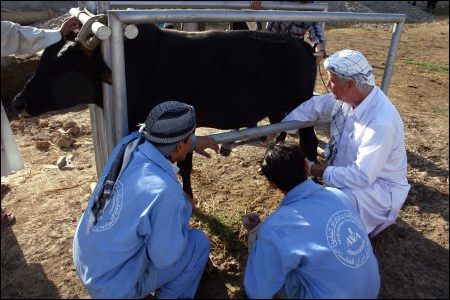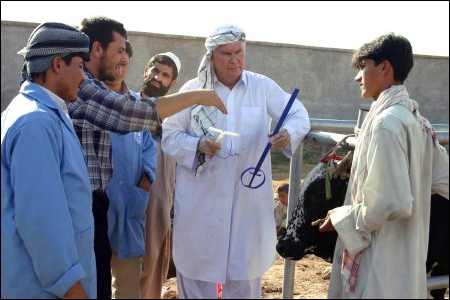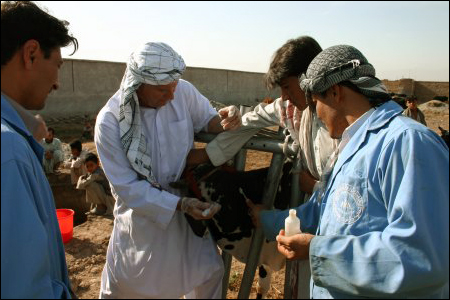- Return to Article Of The Month index
The Power of an Animal
March 2009
Lochrane A. Gary - Hardee County Extension, Director/Livestock Agent
It is early morning in a remote village of rural Afghanistan and we are waiting. We have been here since the curfew lifted and the villagers are bringing in their cattle. We are in a walled enclosure so as not to attract attention, but a crowd begins to gather as the men and boys bring in their cows to be synchronized for artificial insemination. Bulls are arriving to be checked for breeding soundness. And calves by the droves are arriving to be treated for diarrhea and respiratory disease.
A herd health clinic is underway in an effort to protect hundreds of animals from common diseases and to maximize the reproductive performance of village cattle. Over 90 percent of the people in this village rely upon livestock to put food on their table. Each family owns about an acre of land and their sheep, goats and cattle are raised within their walled compound called home. Often the cattle are housed in a dungeon-like, underground prison cell. The purpose is to shelter the animals from cold weather in winter and the blazing sun in summer but more importantly to keep them out of sight of the Taliban who for years have taken or killed livestock for the own purposes. There are no banks in this remote area and these animals serve not only as food but as a savings account and insurance against hard times.
Eighty women farmers are being trained in dairy husbandry in this village. They are provided with a milk bucket with lid, bleach, teat dip, and a mineral block for their family cow. They are also provided with a sickle for harvesting fodder. They are shown how to feed the cow a balanced ration with locally grown feeds. They practice hand milking their cow and are given instruction in sanitary milk handling. Many of these ladies never learned to read so most of the instruction is hands-on and intensely practical. The responsibility of raising livestock falls to the women throughout Afghanistan.
One of these women is named Huma. On a previous assignment in this village her cow had been inseminated. The author had helped her select the bull by showing her pictures from the sire reference catalog. She had selected the bull because he was "handsome." He was also known for calving ease and moderate milk production - just what her cow needed. Huma had brought her cow and its newborn calf for me to see. She was accompanied by her sickly husband and her brother. She beamed with pride as her husband, who had difficulty speaking, told me that she had surplus milk which she was selling to the milk collector for the equivalent of $7.00 per week. Because women are not permitted to work outside the home, she was now able to contribute to the family income without leaving her home. Everybody in the family was happy. We de-wormed the cow, vaccinated it against several local diseases and trimmed its feet as the cow was old.
Several weeks later we had a ceremony where the women were presented with Certificates of Completion of The Dairy Cattle Husbandry Training Course. The certificates were framed with a gold seal and signed by their instructor. Children and family members looked on as the women, one by one were called by name and came forward to receive their certificate. Although Huma's face was covered it had been obvious that she had been crying throughout the ceremony.
As we left the village for the twelve hour trip back to Kabul, I couldn't wait to ask my interpreter why Huma was crying during the ceremony. To my astonishment he replied that her husband had died earlier that morning but that she had come to receive her certificate because I had told the class the day before that after the ceremony I was flying back to America.
Never underestimate the power of an animal.

Training veterinarians in semen collection technique.

Explaining to farmer how his cow will be synchronized for artificial insemination.

Showing veterinarians how to administer drugs.

